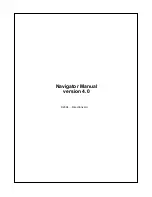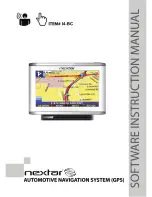
PA G E 5
I N S T R U C T I O N M A N UA L
4 0 6 M H Z P L B
2. Confirm the SAFETY SEAL has not been broken.
3. Check that the batteries have not passed their
replacement date.
4. Inspect the MT410/410G for physical damage
or deterioration.
5. Keep the unit clean by wiping over with a damp cloth
(warm water and mild detergent are suitable), then dry.
If there is any doubt as to the products’ serviceability,
immediately contact your authorised Dealer or Service
Centre for advice.
TESTING THE PLB
It is recommended that you test the MT410/410G at
regular intervals to ensure it is fully functional. You should
also test the beacon prior to an extended journey.
WARNING:
DO NOT
over test – testing consumes
some battery power, no more than once per month.
DO NOT
deploy the antenna as this will break the seal
and activate the beacon to transmit a distress signal
after 60 seconds.
You may test the PLB using the following procedure:
1. Remove the beacon from the carry pouch.
2. Use the key (attached to the lanyard) to slide the self
test switch down and then release, a double beep and
flash of the light will indicate the MT410/MT410G
is functioning correctly.
GPS SATELLITE ACQUISITION TEST
The standard self test procedure is more than sufficient to
perform a comprehensive check of your beacon without
consuming too much battery capacity. On occasions, and no
more regularly than on average once a year, you may wish
to perform a GPS satellite acquisition check (MT410G only).
Whereas the routine self test verifies the GPS receiver’s
circuitry, the full test will include the operation of the
special GPS antenna as well.
1. This test consumes much more power than a standard
self test so choose a test location with good visibility of
the open sky above. A quick satellite acquisition means
a short test, and less wasted power consumption.
2. Carry out a self test in the usual way but rather than
releasing the key, continue to hold it in position.
After
the self test pass confirmation
, both the light flash
and the internal beeper will start. Count a further four
flashes/beeps then immediately release the key.
3. The MT410G will continue to flash and beep whilst it
searches for available satellites. This may continue for
a number of minutes depending on the number and
location of satellites present. It is not possible to abort
the test once started, and note that distress signals are
not radiated as part of this test.
4. If no satellites are found after a predetermined time the
repetitive flash and beep will stop. This may indicate a
fault with the GPS receiver system within the PLB and
you should contact your local service centre for advice.
If the test terminates with a rapid sequence of flashes and
beeps then GPS satellite acquisition and correct operation
has been confirmed.
SAFETY SEAL
The safety seal which covers the antenna on the rear side
of the beacon is designed to tear if the unit is switched on.
A safety seal that is not broken serves to indicate that the
beacon has never been manually activated.
NEVER remove or break the seal unless deploying the PLB
in an emergency. If the beacon has been activated for any
length of time, the batteries can no longer be guaranteed
to have the capacity to operate for the minimum 24 hour
period and therefore must be replaced.
TRANSPORTATION
GME PLBs use batteries with a low level of lithium content.
Consequently GME PLBs are classed as ‘non-hazardous
products’ by IATA and maybe shipped without DG
declaration and carried without problem (accompanied
or unaccompanied) on passenger aircraft. However, it is
advisable that you check with your carrier that they do not
have specific restrictions which may apply to you.
ACTIVATION IN AN EMERGENCY
PLBs should only be activated in situations of grave and
imminent danger. Deliberate misuse may well result in the
unnecessary deployment of valuable Search and Rescue
resources and could incur a severe penalty.
Should there be an inadvertent activation it is the
responsibility of the user to immediately switch the beacon
off and notify the nearest RCC (Rescue Coordination
Centre).
43003-11_MT410&GinsMan.indd 5
26/08/13 3:59 PM





























